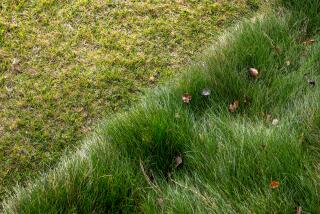The Reward of Proper Sod Installation Is Instant Grassification
- Share via
Second of Two Parts
Question: I would like to replace my old bluegrass lawn with a tall fescue from sod.
How do I go about installing it?
V.C., Laguna Hills
Answer: Here’s how to lay the sod:
* Arrange the first row of sod along a straight line (a driveway or path is a good guide).
If no straight references are available, use a string tied between two stakes.
Do not stretch the sod as you lay it down, as it will shrink slightly.
Keep sod edges in the closest contact possible without overlapping.
Stagger the joints between each piece of sod so that they are not all in the same area. When you reach the edge of the lawn, or in irregularly shaped areas,
use a sharp spade or sharpened masonry trowel to cut the sod to size.
* Once you have completed laying the sod (or if the area is large you may wish to do it in sections), use a weighted roller to ensure good contact between sod and soil, and to eliminate air pockets.
Roll at right angles to the strips, and then roll in the direction the strips are laid.
* If you’re laying sod on a mild slope, start from the lowest spot and move up the hill. Sod should always be laid so it runs perpendicular to the slope.
Staggering the joints between the sod pieces is especially important in such cases in order to avoid excess erosion during the winter rains.
After-Installation Care
* Watering. Don’t ever let new sod dry out. If the sod dries out before the roots have secured themselves in the underlying soil, it will die.
Water lightly two to three times a day for the first week, supplemented by heavier watering once every second or third day.
Keep the soil moist to a depth of 6 inches.
Keep a close eye on the edge of the sod that lines paths and driveways, as this will be the last to knit with the soil and the first to dry out.
The sod should become established in one to three weeks.
You can tell that roots have taken hold when the grass seems secure when gently tugged. At this time, gradually taper off on watering, dropping back to once a day, then every other day and then every third day or so, depending on weather conditions.
Test the grass for moisture
level when setting a watering schedule. Don’t rely on the day of the week. You want to water when the first 6 inches are approaching dryness.
You can test for watering readiness by sticking a finger in the soil or digging down with a trowel. Or you can walk on the grass. If it springs back readily, then it probably has enough water.
But if your footprint is still there a few minutes later and the grass has a blue-gray tinge, it’s time
to water.
Watering only when the turf dries out will create a stronger, longer-lived lawn with a well-established root system.
* Mowing. Once the grass is 2 to 3 inches tall and seems to be growing well, it can be mowed. Tall fescue prefers to be mowed at a height of 1 to 3 inches. Try to avoid removing any more than one-third of the growth at any one mowing.
* Fertilizing. If adequate fertilizer has been added to the site during preparation, it is usually not necessary to fertilize again for at least six weeks, or whenever the lawn starts yellowing and showing the need.
* Usage. Initially minimize foot traffic to allow the grass to become established.
A Problem in Your Yard?
University of California Cooperative Extension (UCCE) Master Gardeners are here to help. These trained and certified horticultural volunteers are dedicated to extending research-based, scientifically accurate information to the public about home horticulture and pest management. They are involved with a variety of outreach programs, including the UCCE Master Garden hotline, which provides answers to specific questions. You can reach the hotline at (714) 708-1646 or send e-mail to ucmastergardeners @yahoo.com. Calls and e-mail
are picked up daily and are generally returned within two to three days.






